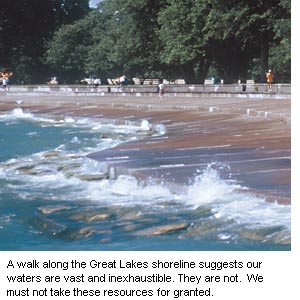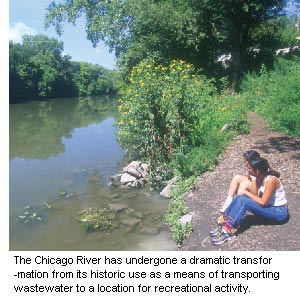Introduction to Green Design
 |
Green design is a broad heading that includes a number of concepts involved in the Chicago Water Agenda. For your convenience, we provide links and information associated with the concept of Green Design, even though they are drawn from other agenda items.
“Chicago’s world-class status is owed largely to its position at the confluence of the Chicago River and Lake Michigan. These waterways signified transportation and trade to Chicago settlers and continue to attract millions of visitors to our city every year. |
Beyond the Lake Michigan shoreline, our water resources extend beyond, and beneath, the City. They are the Chicago River, Lake Calumet, the Calumet River, thousands of acres of wetlands, creeks, streams, and lagoons, as well as canals and channels.
Equally important are the thousands of miles of pipes, man-made tributaries, that have – for over a hundred years – delivered drinking water and helped us manage stormwater.
"These resources are critical to our public health, safety, economy and quality of life. They provide recreational opportunities like boating, fishing and swimming. Our waterways provide natural experiences in an urban setting. We are fortunate to live near some of the cleanest drinking water in the world.” City of Chicago’s Water Agenda 2003.
This guide is intended to be a first step in addressing the challenge of better managing our water. Specifically, it provides guidance to developers, residents, and other community members on methods to protect our water resources by reducing the amount of stormwater draining into the sewer system and local waterways.
Stormwater runoff from developed land in the City of Chicago causes a number of problems when it is not effectively managed. Excess stormwater can cause basement and street flooding, as well as overflows to the Chicago River and backflows to Lake Michigan that result in beach closings. Where stormwater is discharged directly to waterways, such as the Chicago River, it degrades water quality. Since most runoff in the City is captured by combined sewers and routed to treatment plants, increased runoff raises the cost of wastewater pumping and treatment by the Metropolitan Water Reclamation District.
When does stormwater become a problem rather than a resource? First, we need to understand how stormwater moves through the City. Increased stormwater runoff is caused principally by impervious (impenetrable) surfaces – conventional rooftops, parking lots, roads, alleys, playgrounds, and sidewalks. Developers typically seek to rapidly move stormwater away from the development site via gutters, sewers and artificial channels. While this approach is intended to prevent local flooding and undesired water ponding, it may actually cause flooding. It also short-circuits the opportunity for water to naturally soak into the ground – to water plants and recharge groundwater resources.
Fortunately, there are both proven and evolving alternatives to conventional drainage techniques and site designs that can substantially reduce surface runoff quantities and resultant pollutant loadings. These alternative development techniques, commonly called Best Management Practices or BMPs, are aimed at soaking up every drop of rainwater close to where it falls. Common goals of Best Management Practices are to:
- reduce the amount of impervious surface areas to reduce stormwater runoff
- utilize the landscape and soils to naturally move, store and filter stormwater runoff before it leaves the development site
|
While it is true that some of the Best Management Practices recommended in this guide will require a rethinking of current stormwater design philosophy, there are many opportunities to incorporate the recommended approaches on most development sites, including design layouts for individual buildings and larger developments. Many of these practices can reduce both construction costs and long-term maintenance costs. Every development can benefit by applying Best Management Practices. In assessing which practices are best for a site, it’s necessary to consider site features, size, location and usage.
|
 |
Natural drainage practices, in combination with design approaches that minimize impervious areas, can significantly reduce development costs. These savings can improve construction affordability and maintain acceptable standards of public health, safety and welfare.
